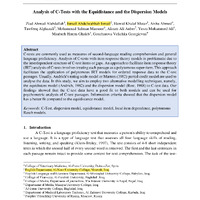Item
Publication
Analysis of C-Tests with the Equidistance and the Dispersion Models
- Title
- Analysis of C-Tests with the Equidistance and the Dispersion Models
- Abstract
- C-tests are commonly used as measures of second language reading comprehension and general language proficiency. Analysis of C-tests with item response theory models is problematic due to the interdependent structure of C-test items or gaps. An approach to facilitate item response theory (IRT) analysis of C-tests involves treating each passage as a polytomous super-item. This approach facilitates the application of polyomous IRT models for ordered response data to the C-test passages. Usually, Andrich’s rating scale model or Masters (1982) partial credit model are used to analyse the data. In this study, we aim to employ two alternative modelling techniques, namely, the equidistant model (Andrich, 1982) and the dispersion model (Rost, 1988) to C-test data. Our findings showed that the C-test data have a good fit to the both models and can be used for psychometric analysis of C-test passages. Information criteria showed that the dispersion model has a better fit compared to the equidistance model.
- Scientific Type
- اكاديمي
- Journal volume
- vol.13,Special Issue
- Collaboration type
- مشترك
- Publish Date
- March 1, 2023
- Participated Universities (Publication)
-
 Alnoor University
Alnoor University
- Scopus status
- In Scopus
- Scopus index year
- 2 023
- Scopus quarter
- 1
- Scopus citation score
- 2.099999905
- Clarivate status
- Not In Clarivate
- Pub. Med. status
- Not In PubMed
- Author (Publication)
-
 إسماعيل عبد الوهاب إسماعيل محمد
إسماعيل عبد الوهاب إسماعيل محمد
- Journal (Publication)
-
 International Journal of Language Testing
International Journal of Language Testing
- Publisher (Publication)
- Tabaran Institute of Higher Education (Iran Ministry of Sciences)
- ISSN
- 2476-5880
- Country (Publication)
-
 Iran
Iran
- Country type
- عالمية
- College (Publication)
-
 College of Education
College of Education
- Departement (Publication)
-
 Department of English Language
Department of English Language
- Media
-
 Academic Paper
Academic Paper
Part of Analysis of C-Tests with the Equidistance and the Dispersion Models

